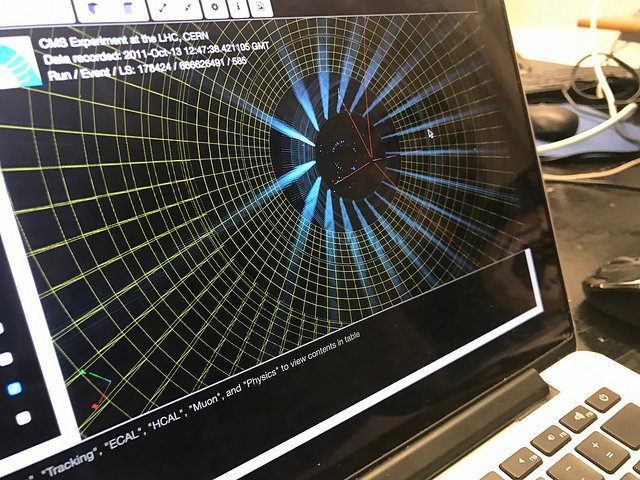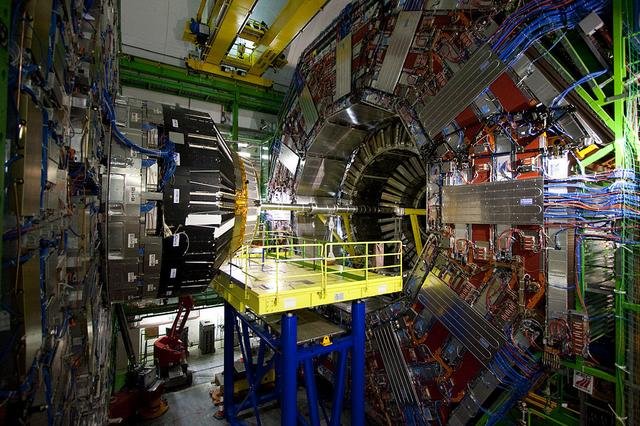It is now about two weeks that I did not post anything in English. My time for posting and reading is unfortunately currently very limited. The development of steemstem.io keeps me super busy (I will post an update on @lemouth-dev very soon), and taking part to the @steemalliance working group makes my agenda even more complex.

[image credits: Laura Gilchrist (CC BY 2.0)]
At the same time, I have also managed to release my first scientific article of the year, entitled ‘Sleptons without hadrons’.
To make a long story short, collaborators and I proposed a novel method to increase the sensitivity of the Large Hadron Collider at CERN to new particles that are weakly interacting (and thus associated with very rare signals).
Our findings demonstrated that the reach of the LHC can be improved by a factor of a few when our method is used instead of more standard ones. And to put things into perpective, a factor of a few is something very large! This is what I will discuss today.
Vetoing hadrons in a nutshell
The method that we proposed relies on the selection of events (i.e., recorded collisions) where there is little hadronic activity. In other words, the amount of energetic hadrons (composite states bound by the strong interaction) is limited.
Before moving on, let me recall that a specific phenomenon (associated with a new particle) can be rare for two reasons. The first reason corresponds to the fact that the new particle can be heavy. Anything heavy is automatically linked to a small production rate. The second reason is related to the fact that the new particle could be weakly interacting (and by virtue of the weakness of its interactions, its production rate is small).
Our work focused on the second item.

[image credits: Domenico Salvagnin (CC BY 2.0)]
Weakly-interacting particles are ignorant of the strong interaction, so that any LHC event in which such a particle would be produced would feature a small amount of energetic hadrons (hadrons are linked to the strong interaction).
In contrast, in the context of the Standard Model, most common phenomena are associated with an important hadronic activity.
We thus have a potential good handle on weak signals: vetoing the selection of events featuring a large hadronic activity.
This is however used for ages and there is in principle nothing new here. If the hadronic activity (i.e. the amount of energetic hadrons) is above some threshold, the collision event is ignored. If it is below the threshold, it is selected. The novelty of the method that we proposed was to replace the fixed threshold by a dynamic one.
Instead of comparing the hadronic activity to a fixed energy value, we instead decided to compare it with the leptonic activity of the event, i.e. the activity associated with the non-strongly-interacting electrons and muons present in the event. By doing so, we found out that even more Standard Model background events were rejected during the selection process, so that a better handle on the signal process was possible.
The slepton example
Let us now move on with the first word of the title of my article: sleptons.
In order to illustrate the strength of our method, we picked up supersymmetry, one of the most studied theories extending the Standard Model of particle physics. I recall that we have very good reasons to think that the Standard Model should be extended.
We then focused on one of the most weakly interacting particles of such theories (and thus one of the most harder supersymmetric particles to find), the smuon. This particle is the supersymmetric partner of the Standard Model muon, the heavy brother of the electron (a muon is like a heavy and instable version of the electron).
The corresponding collider signal is very simple: one produces two smuons that then decay each into a muon and a dark matter particle (that is invisible). Therefore, one must search for two muons (that can be reconstructed in the detector) and some missing energy (that can also be reconstructed). The LHC being a strongly-interaction-based machine, this clean final-state is then polluted by some hadronic activity but the latter is limited, as it cannot originate from the signal itself.

[image credits: arxiv]
Our findings are summarized in the money plot on the left. We present what an analysis using the dynamic jet veto introduced above could do, relatively to what a standard analysis using ‘normal’ vetos does.
In the figure, we hence show the ratio of the sensitivity of the two analyses as a function of the mass of the two new particles, the smuon mass (x-axis) and the dark matter mass (y-axis).
In the area in dark blue, our novel method does worse or as good as the former one. In all other areas, our method does better (the ratio is larger than 1). I think there is no need to discuss further, our proposal is superior in almost all the parameter space!
Take-home message
SteemSTEM is pushing for science communication on Steem, so that Steem can be used for actual science communication. This is what I have done today, by discussing my own research work.
I have introduced what my collaborators and myself did in our first scientific article of the year. We presented a novel method targetting hypothetical weakly-interacting particles that could be produced at the LHC. The method relies on the fact that those new particles are associated with collision events featuring very few energetic composite states related to the strong interaction, despite the fact the LHC is a strong-interaction-based machine.
By making use of the amount of hadronic activity (the energy of these composite states) and the activity of the non-strongly interacting particles often produced in the decay of weakly-interacting new particles, we have demonstrated that the sensitivity of the LHC to those new guys could be improved by an important number. We have illustrated our findings with a specific example, and it actually works.
Our next step consists now in convincing our experimental colleagues to use the method. This is what I will do today, right after having posted this article :D
SteemSTEM
Make sure to follow SteemSTEM on steemstem.io, Steemit, Facebook, Twitter and Instagram to always be up-to-date on our latest news and ideas. Please also consider to support the project by supporting our witnessdelegating to @steemstem for a ROI of 65% of our curation rewards (quick delegation links: 50SP | 100SP | 500SP | 1000SP | 5000SP | 10000SP). (@stem.witness) or by
Hey, you are a scientist at CERN !
That's amazing, I didn't know that. Till now you were only known to me as a coding geek at Github who also remains active on Discord, and probably the creator of Steemstem.io !!
:D.
Amazing !
Must be having a really hectic and interesting schedule hunting down bosons, and other exotic subatomic particles !
Your safe must be full of a lot of antimatter (atleast a few milligrams) ! :P
And I will definitely not forget to pester you with my exquisite assortment of crazy physics questions whenever I can get hold of you ! I hope you wouldn't let me down !! Ha-ha !
Great work.
I was working at CERN in 2012-2014, but I am now working in Paris. However, a significant fraction of my work is connected to what is going on there. This is actually my main work. Developing steemstem.io is actually what I do during me free times... because we have currently no one else to do it (I learned javascript from scratch for that) :D
As I am a theorist, I have nothing in my safe... sorry :D
Except this, feel free to shout any question at me. I will try to answer as much as I can :)
Yayy!
Getting my doubts cleared by a physicist from CERN would be just so extraordinary! :D
I'll also try learning JS in my free time.
Thanks.
Good luck with the learning phase :)
Thanks :)
Congrats on the publication!
I definitely think having SteemSTEM members share what their currently working on is a great way to bolster the community. In fact, trying to understand your work is the most exposure to the field I've ever had. Thanks!
I hope the post is understandable enough. Without much feedback, this is hard to me to assess. Thanks for reading, and don't hesitate to ask any question if you have some.
Why is it that the most accomplished people are often the most gracious? A topnotch scientist and you always extend yourself to others.
I admire you.
Many thanks! I appreciated your nice message :)
🙂
Is that the PC term for anti-social?
Congrats on your first article of the year, may there be many more, and good luck making your case to the experimentalists!
Your real last name looks more made up than your steemit nickname......
I think the anti-social term is non-interacting, no? Or just dark :D
This was earlier today and it seems to have worked well. Now, the future will tell us how good this was :)
Believe me, I know all the jokes :D
Beautifully structured. You seem to have mastered the steemstem interface quite well. Do particle physicists ever collaborate with folks in other fields? This totally looks interesting but all I can think of is if someone in the plant ecology world can ever enter into collaborative research with a particle physicist :)
It happens (mostly with IT people). However, for the rest, I am not too sure :)
Congratulations on your publication!
Thanks a lot! :)
Hi @lemouth!
Your post was upvoted by Utopian.io in cooperation with @steemstem - supporting knowledge, innovation and technological advancement on the Steem Blockchain.
Contribute to Open Source with utopian.io
Learn how to contribute on our website and join the new open source economy.
Want to chat? Join the Utopian Community on Discord https://discord.gg/h52nFrV
Your post was mentioned in the Steem Hit Parade in the following categories:Congratulations @lemouth!
Congratulations @lemouth! You have completed the following achievement on the Steem blockchain and have been rewarded with new badge(s) :
Click here to view your Board
If you no longer want to receive notifications, reply to this comment with the word
STOP"new particle could be weakly interating... they are ignorant of the strong interactions... would produce a small amout of energetic hardrons.." => I don`t know about particles, so please bear with me if my question is stupid. What would happen if the new particle was created by strong interactions and the new particle is not "heavy" ? Can we still call that a new particle?
I am not too sure to get the question. Please let me try to answer anyways. A new particle is new by definition. The properties of this new particle can be very varied. It could be sensitive to the strong interaction, the weak interaction, etc. This will fix the way particles can be produced (via strong or weak forces, etc.).
To answer the second part of the question, new particles can be light. One just must be sure they are stealthy enough to guarantee the fact that we have not observed them yet.
I hope this helps!
I am not too sure to get the question. Please let me try to answer anyways. A new particle is new by definition. The properties of this new particle can be very varied. It could be sensitive to the strong interaction, the weak interaction, etc. This will fix the way particles can be produced (via strong or weak forces, etc.).
To answer the second part of the question, new particles can be light. One just must be sure they are stealthy enough to guarantee the fact that we have not observed them yet.
I hope this helps.